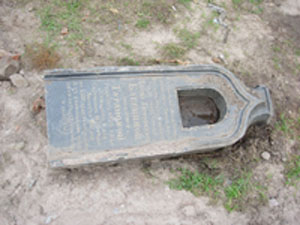Monument to Lenin in St.Petersburg was built with 19th century tombstones
It is very likely that the tombstones were delivered to Lenin Square during construction work in 1926

Construction workers found a few tombstones dating back to 19th century as they conducted excavations and ground moving at Lenin Square near the Finlyandsky Railway Station. Twenty fountains and some waterfalls should be built at the square in front of the Finlyandsky Railway Station by this fall. 
In the past there has been no cemetery in the area where Lenin Square is now located. So where did the tombstones come from? According to a foreman, three tombstones have been found by his workers. One tombstone's foundation is now covered with earth again. A piece of the border stone with an epitaph on it was lost in the heap of broken granite.
It is very likely that the tombstones were delivered to Lenin Square during construction work in 1926. The Bolsheviks decided to erect a monument to Vladimir Lenin shortly after his death in 1924. The monument was unveiled on October 7th 1926. The square had to be rebuilt to a certain extent after the installation of the monument.
A great amount of construction materials were required for large-scale construction projects of the 1920s-1930s. The numerous cemeteries with their sumptuous tombstones in St.Petersburg seemed to be a perfect source of construction materials. The Bolsheviks used the tombstones for building new facilities while erasing memories of the old, corrupt bourgeois world.
An administrative building of the OGPU (the government's secret-police organization) in the Leningrad Military Region is yet another example of using tombstones for construction purposes. A large number of tombstones were used for building the notorious OGPU headquarters in Liteiny, 4. The building has been known as the Big House. Many tombstones were used as border stones during the  construction. Tombstones were previously found during the pavement reconstruction near the Kazan Cathedral, in Inzhenernaya street. Now they came to light at Lenin Square.
construction. Tombstones were previously found during the pavement reconstruction near the Kazan Cathedral, in Inzhenernaya street. Now they came to light at Lenin Square.
The authorities wiped out a number of cemeteries in St. Peterburg in the 1920s and 1930s. Vyborgskoye Roman Catholic cemetery lasted until 1950. The cemetery was located in the vicinity of the Finlyandsky Railway Station, in the area of Arsenalnaya street. It was Russia's largest necropolis where about 40 thousand people (Poles, Germans, French and Italians) were laid to rest.
Subscribe to Pravda.Ru Telegram channel, Facebook, RSS!


